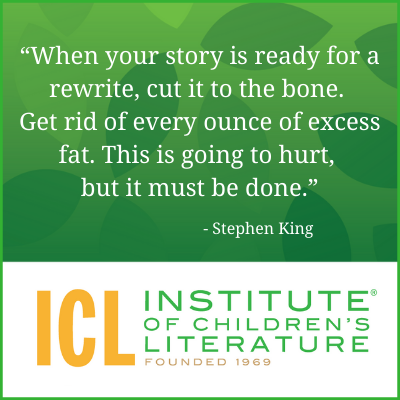
5 Ways Writers Can Prep for 2025 Goal Setting
Before we roll on to the new writing year, let’s harness our optimism for the blank slate before us and prepare for our 2025 Goal Setting just for writers.

One of the most difficult and important parts of the revision process involves cutting words you’ve written. If you’re writing for magazines in fiction or nonfiction or early chapter books or picture books, cutting is a difficult step to avoid. Word counts aren’t suggestions to be ignored because you have something you simply had to add. They are put in place because of the very physical needs of the publishing process and/or the reading public. Magazines, for example, cannot add an extra page to the magazine simply because some of the writers felt they could exceed the word count requirements. And picture book publishers are often well aware that shorter books perform better in the market than longer books, and they buy accordingly. That means skipping the step of cutting can do more than give you weaker writing. It can quite literally ruin your chance for a sale.

As it turned out, that wasn’t right. The magazine replied to my submission with lots of positive feedback and an offer to look at it again once I got it below the word count. And the word count they quoted was even shorter than the one I’d been shooting for previously! Eek! But with the magazine’s interest urging me on, I began cutting. I had to cut things I didn’t want to, but ultimately, I was able to bring it within the word count and I made the sale. I suppose the moral of that story is that you can cut out so much more than you think. You simply must be motivated to do the job.
Sure, you might think, word counts are important in magazine writing and in picture books, but do they matter much in novels? The answer is yes. Though fantasy novel readers are notoriously patient with extremely long novels, most readers of other genres are considerably less so. Even with fantasy novels, readers only accept the extra length when the content is interesting, engaging, and without drag. The truth is that cutting words does more than meet a preset “rule” of publishing; it tightens up your writing and makes it more engaging. It improves your chance of securing an agent or publisher and increases your chance of reader satisfaction. Still, that leaves us to face the problem of deciding what to cut.
As you go through your manuscript deciding what to keep and what to cut, the question in the forefront of your mind should always be: why is this here? Whether you’re writing fiction or nonfiction, every section and sentence of the piece needs to have a reason for being there. This can be a real problem for organic writers who don’t outline before they write, and therefore can be led off onto tangents that don’t end up serving the overall piece. Ask yourself, what does this do for the piece as a whole and what does it do for the reader?

Some writers call this “killing your darlings.”
This is when you cut things you like because they serve no overall purpose to the book, short story, or article. For every section—in fact, for every sentence—ask yourself: why is this here? Cut anything that has no real reason for being there and look closely at anything that doesn’t have more than one reason for existing. Strong writing choices will almost always do more than one thing. For instance, a strong scene may demonstrate character, introduce an important element or setting, and advance the plot. Multitask your writing and you’ll get more done with fewer words.
Another area of multitasking that tightens up your fiction could be consolidating characters. Sometimes you have characters who serve no real purpose other than to be in a place and say words. I’ve seen this often from writers who are recreating a family story but trying to do it as fiction. The original family had three kids so the story has three kids, but sometimes that’s not enough reason for them to be in there. If the story will work when you merge two of the kids into one, then do it. It’ll give each character more to do, allow you to make them stronger, and run less risk of confusing readers.
A scene may exist in a book to move the plot forward. It may exist to establish relationships between two characters. It may exist to demonstrate a character’s personality or to show the reader a character’s weakness or strength that will be important for the story. It may exist to introduce an element that will become important later. For example, an action moment where my character grabs her sketchpad and sharpens her pencil in case she has time to do some sketching at the rodeo may only become important later when my character uses the super-sharp pencil to stab a bad guy who tries to kidnap her.

For instance, in the scene that shows two characters’ fondness, does it also show that fondness is beginning to turn into something else? That second thing would make the scene a keeper because it makes it unique. What your scenes and sentences do should be both important and unique. Don’t do the exact same thing in slightly different ways when it’s not necessary and doesn’t add something new.
Often times when I’m trying to reduce the word count for an article or short story, I reach a point where I’m certain I’ve covered the important things only once and that the structure of my piece is sound. I can’t do any large cuts unless I want to start damaging the value of the overall piece. In situations like that, I often start cutting word by word.
One way I’ve done this is by looking at each sentence and trying to rewrite it with fewer words. Consider the following:
“Just sit down and listen,” he said, sounding as if he expected to be obeyed.
Now maybe I really need him to order the second character around in this very specific way. But I need to lose some words. Here, there are quite a few we can lose. Let’s begin at the beginning. “Just” in this context is almost never needed so I toss it without concern. Now my scrap of dialogue reads like this:
“Sit down and listen, he said, sounding as if he expected to be obeyed.
Next, I think about “sit down.” Realistically a person can sit up or sit sideways even, but usually “down” is a given in this kind of context, so I can cut this too. Now the dialogue is two words shorter:

Hmm, somehow that doesn’t have the same commanding feel. Let’s try this:
“Sit! Listen!” he said, sounding as if he expected to be obeyed.
Now that does sound more commanding again, but I may have to tinker a little to get the sound smoother. In the meanwhile, I’m seeing that I have far too many words in the speech tag. The guy is ordering someone around, so why do I need to over-explain it? How about this:
“Sit!” he demanded. “Listen.”
I like “demanded” here but I could also have used “ordered.” In any case, I’ve gone from 15 words to four words. I’ve also divided my quoted dialogue into two parts, thus giving each command more punch. If I can do that kind of cutting over and over, I’ll end up with a manuscript that is substantially shorter without losing any of the structure from the original. I’ll still have every scene and every moment that I wrote, I’ll simply have them in a form that is more direct.
Many writers think of cutting as hurting their work. The reality is that direct writing has more energy and engagement than rambling prose. Cutting can make your writing cleaner and better. But it still must be undertaken purposefully. The key to cutting is very similar to the key to good writing: Have a reason for what you cut. Don’t simply begin whacking away to make a piece shorter. Instead, question, examine, and dissect so that you can find the places where excess exists. The excess may be places where you wandered from the point. It may be where you repeated yourself unnecessarily. It may be where your sentences grew bloated with unnecessary words. But finding that excess will guide you to smart cutting that leaves you with better, stronger writing that fits your needed word count. That’s multitasking at its best.
With over 100 books in publication, Jan Fields writes both chapter books for children and mystery novels for adults. She’s also known for a variety of experiences teaching writing, from one session SCBWI events to lengthier Highlights Foundation workshops to these blog posts for the Institute of Children’s Literature. As a former ICL instructor, Jan enjoys equipping writers for success in whatever way she can.

Before we roll on to the new writing year, let’s harness our optimism for the blank slate before us and prepare for our 2025 Goal Setting just for writers.

Writers can be thin-skinned when it comes to getting feedback on their work. Let’s look at 4 ways to positively deal with constructive criticism!

Rejection is part of the territory when it comes to being a writer. Today we offer reflection for writers to help redirect your efforts after a rejection.
1000 N. West Street #1200, Wilmington, DE 19801
© 2024 Direct Learning Systems, Inc. All rights reserved.
1000 N. West Street #1200, Wilmington, DE 19801
© 2024 Direct Learning Systems, Inc. All rights reserved.
1000 N. West Street #1200, Wilmington, DE 19801
© 2024 Direct Learning Systems, Inc. All rights reserved.
1000 N. West Street #1200, Wilmington, DE 19801
© 2025 Direct Learning Systems, Inc. All rights reserved.
1000 N. West Street #1200, Wilmington, DE 19801
©2025 Direct Learning Systems, Inc. All rights reserved. Privacy Policy.
3 Comments